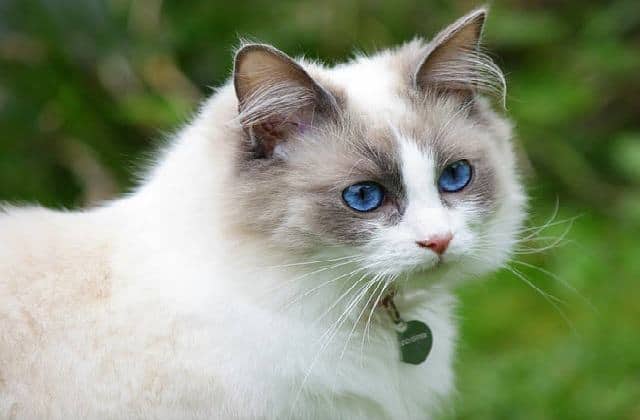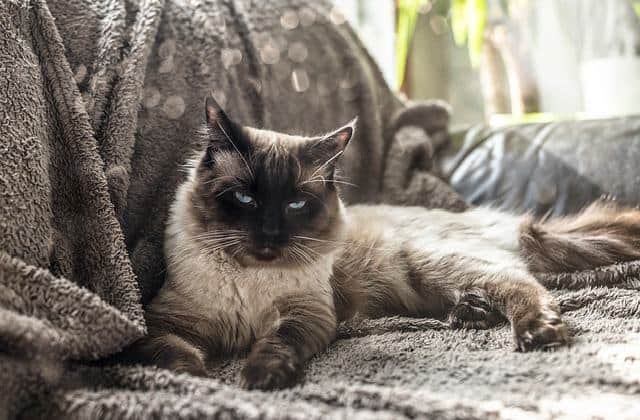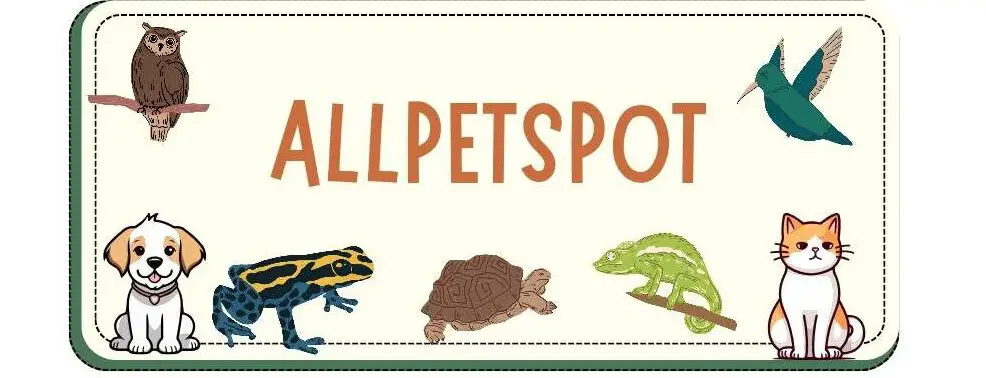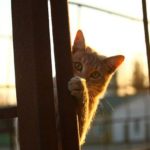Ragdoll Cat Breed Information – Ragdoll is among the popular breeds of cats in the United State, this because of the unique characteristics which we will be discussing today.
Ragdoll is a large and muscular semi-longhair cats with a soft and silky coat and a color point coat and blue eyes. Developed by American breeder Ann Baker in the 1960s.
Read more about Ragdoll size vs Normal Cat | Size, Color, Price, Personality & More
Ragdoll Cat Breed Information

Here are important Ragdoll Information, Appearance, Health, Personality & Temperament, Shedding & Grooming, Life Expectancy, and all you need to note.
Ragdoll Appearance
Ragdoll Height
Ragdoll is a large breed of cat that a full-grown male on average can grow up to 23 – 28 cm, while the full-grown female ragdoll can grow up to 21 – 26 cm tall.
Ragdoll Length
A full-grown male ragdoll can grow to a length of 43 – 53 cm, while on average a full-grown female ragdoll can grow to a length of 41 – 51 cm long.
Ragdoll Weight
A full-grown male ragdoll can weigh around 5.4 to 9.1 kg, while on average a full-grown female ragdoll can weigh around 3.6 to 7.8 kg.
However, the feeding pattern can affect the weight of both male and female ragdoll.
Find out more about Ragdoll Color Progression – The Chemistry Of Ragdoll Colors Changes.
Ragdoll colors
Ragdoll comes in different colors which are as follows;
- Chocolate: Reddish-brown
- Seal: Dark brown
- Flame: Deep orange
- Torbie: Stripes and patches of cream or flame on the points
- Blue: Soft, deep blue-gray
- Cream: Nearly apricot
- Lilac: Light gray with pink undertones
Ragdoll Patterns
Ragdoll comes in six different patterns as identified by most breeders, which are as follows;
- Torbie: The ragdoll cat has a mix of Tortie and Lynx breeding, and these include both stripes and red/cream coloring.
- Mitted: The grain of this model is so dark that it contrasts with the body and the forelegs have white markings with the gloves. Just like pointed, but with white paws and belly. With or without a flame (white lines or patches on the face), but there should be a “line on the belly” (white line from the chin to the genitals) and a white chin.
- Lynx Point: This pattern overlays the above patterns, and shows ticking or stripes on the face.
- Color point: This pattern shows a definite color contrast between the body and the points.
- Tortie Point: This pattern overlays the above patterns, and mixes in red or cream with the other colors.
- Bi-color: White legs, white inverted V on the face, white abdomen, sometimes white patches on the back. (Excessive amounts of white, or “high white”, on a bi-color are known as the Van pattern, this is rare compare to the other patterns.)
More to read; Why Are Cats Attracted To My house? – 7 Top Reasons
Ragdoll Personality and Temperament
Ragdoll cats are known to be gentle, calm and sociable. Unlike most cats, the ragdoll falls into the arms of anyone who is holding it, even when lying on their back.
They love their people, greet them at the door, follow them around the house, and jump on their laps or curl up on the bed when the opportunity arises.
They often learn to come when called or get toys that have been thrown at them.
Ragdolls have good manners and are easy to live with.
You can find rag dolls on your sofa or bed, but they’re generally not that much bigger.
A ragdoll would rather be on the same level as his people than at the highest point in the room.
Ragdolls connect without request and have an almost dog-like devotion to their owners.
Some people also say that they are in tune with emotional needs, a trait that makes them ideal companions.
Although they are usually submissive and kind-hearted, it is important to remember that their upbringing is just as important as their natural nature, and you still need to communicate and care for your ragdoll kitten just as you would any other kitten.
Ragdoll Coats
Ragdoll kittens have very soft fur like rabbits. When they are firstborn, their fur is pure white or pale cream in color. It usually takes about ten days to show the true color.
As the coat matures, the coloring is directed towards the limbs, similar to that of a Siamese cat. Its body is much lighter than its legs, tail and face.
Normally, their coat won’t reach their full color until the cats are about two years old, so they mature slowly by certain standards.
Although this breed appears almost to have long hair due to its abundance of fur, it is actually only considered a medium-sized breed, which makes it easier to care for the cat than the real long-haired breed.
Ragdoll Shedding & Grooming
Ragdoll coat is medium length and smooth texture. Need regular maintenance so that it is always in good condition.
You should use a wide-toothed comb to remove creases and avoid creases. If their hair is very matted, you may even need to shave the ragdoll.
Unlike some cat, the Ragdoll has one layer without an undercoat. This can make them more suitable for some people with allergies.
Trim a ragdoll nails as needed, usually every 10 days to two weeks. Always remember that the ragdoll is prone to periodontal disease.
So it’s important to brush the ragdoll teeth at home with a veterinarian-approved pet paste and schedule a pet cleaning if necessary.
Even though Ragdoll is not completely hypoallergenic, the ragdoll lack of undercoat also makes shedding more manageable.
Use a stainless steel comb to groom it once or twice a week to prevent or remove any mats or tangles.
The only other grooming a ragdoll require is regular nail trimming and ear cleaning.
Ragdoll Medical Concerns
Here are some health concerns about ragdoll cat breed you should know.
Gastrointestinal disorders
The Ragdoll, like all cats, can suffer from digestive problems.
The gastrointestinal tract is a long winding tube that starts at the mouth and ends at the anus, with various twists along the way.
Diseases such as infectious gastroenteritis (such as colitis), poisoning, or intestinal obstruction often cause vomiting and / or diarrhea.
Treatment will depend on the exact cause, however prompt intervention usually results in full recovery.
Kidney disease
A cat’s kidneys are responsible for filtering waste products from their blood into their urine.
Ragdolls can be affected by kidney disease caused by infection, blockage, tumors or toxins (especially licking frostbite), as well as age-related changes.
Chronic kidney disease occurs when kidney function gradually deteriorates over time.
Treatment depends on the cause and extent of the damage, but usually begins with flushing the kidneys with intravenous fluids, followed by diet and special medications.
Unfortunately, kidney disease cannot be cured, but with the right support, many cats can lead relatively normal lives.
Mouth and gum disease
Ragdolls can suffer from gum and tooth disease throughout their life. Gum disease occurs when some (or all) of the supporting structures in a tooth become inflamed.
It begins when food, bacteria, and minerals build up along the gum collection, resulting in a build-up of brown scales known as tartar.
If this damages the gums, a small spaces can form between the gums and teeth where bacteria can grow, leading to what is known as periodontal disease.
This condition can be prevented by routine primary care, such as feeding the cat dry food and brushing its teeth on regular basis.
Heart disease
Heart disease in cats refers to cases when the structure of the heart is not functioning properly.
Heart disease falls into two categories: congenital (which means the cat will be born with it) and acquired (which means the disease will develop at a later date).
Congenital heart disease includes defects in the heart wall, abnormal valves, and blood vessels.
Ragdolls are prone to a condition called hypertrophic cardiomyopathy, which can lead to heart failure.
Although this condition cannot be treated, it can be treated with lifelong treatment.
Symptoms of Ragdoll Medical Concerns
- Fainting; your ragdoll may on its own without stress just faint then consider going for any of the above medical test.
- Blood clotting; is an important process that prevents excessive bleeding when a blood vessel is injured, therefore when your Ragdoll gets injured the blood can clot.
- Strokes; if you notice any symptoms, just talk to your vet.
- Sudden death; this occurred because you never paid attention.
Recommended; 9 Ways To Stop A Cat Running Away From Home
Ragdoll price
Prices of a ragdoll will vary according to the breeder and the quality, age, current country exchange rate, location of the breeder, but generally on average a healthy ragdoll will cost around $800 to $2000.

Ragdoll Adaptability to other pets
The Ragdoll cat is an easy-going breed of cat and will always get along nicely with other household pets.
However, you must give a ragdoll some time for transition and adjustments.
The ragdoll seems to always enjoy the presence of other pets they were properly integrated, whether another Ragdoll, another cat or even a dog.
Ragdoll Vocal Abilities
The ragdoll will always tend to be very vocal more than most average cats.
An average ragdoll will very vocal when trapped in a room or on the ‘wrong side’ of a door.
The ragdoll can be vocal when sick or in the need of attention from their owners.
However, the vocality depends on the individual personality of the cat or the current need.
Ragdoll Life Expectancy
The Ragdoll is a breed of cat that generally has a decent life expectancy.
When properly cared for and feed the ragdoll can live for about 14 to 17 years, depending on factors like; genetics, health status, environment and diet.
Recommended; 10 Best Things to do to Find a Lost cat
Ragdoll Kid Friendly
The ragdoll have proven to be very good with kids.
Every ragdoll cat always love to get dressed up just like humans, and most importantly the ragdoll love to be cuddled and hugged by kids.
Ragdoll General Breed Characteristics Summary Table And Rating
| Adaptability | 5 stars | Energy Level | 3 stars | Shedding Level | 3 stars |
| Affection Level | 5 stars | Grooming | 2 stars | Social Needs | 5 stars |
| Child Friendly | 4 stars | Health Issues | 3 stars | Stranger Friendly | 3 stars |
| Dog Friendly | 5 stars | Intelligence | 3 stars |
Find out more about the Bad Things About Ragdolls & Solutions.
Cheers!!!










